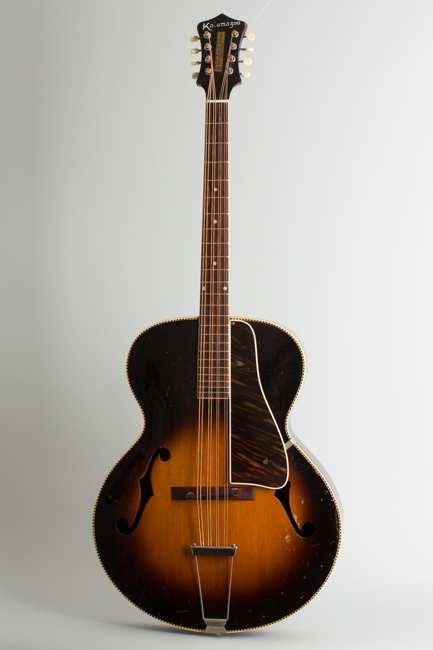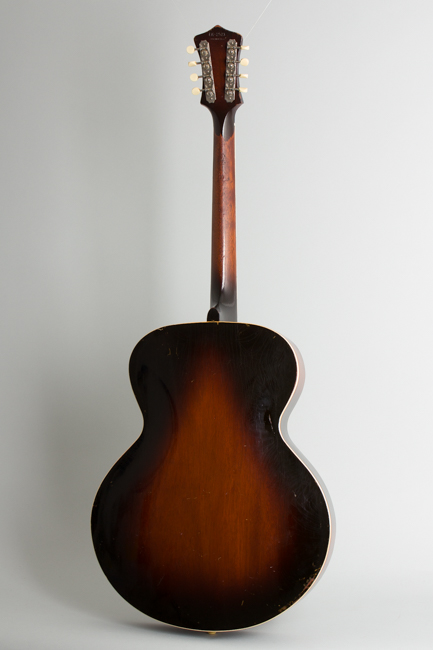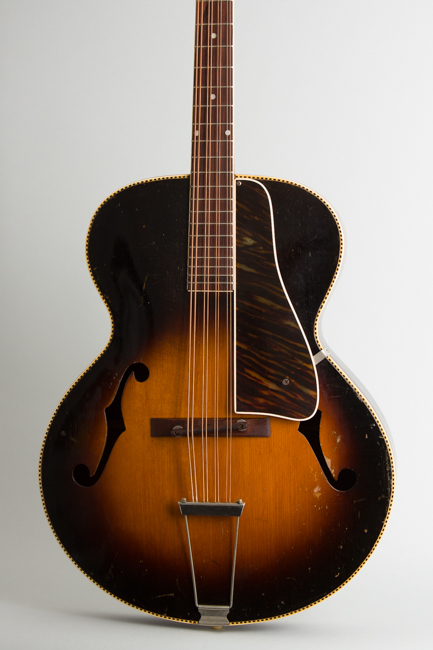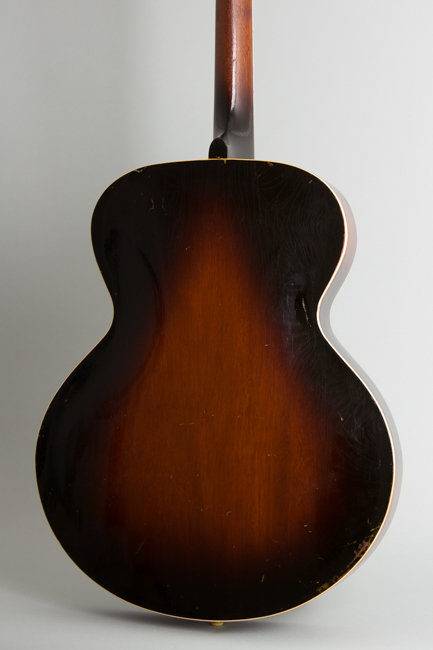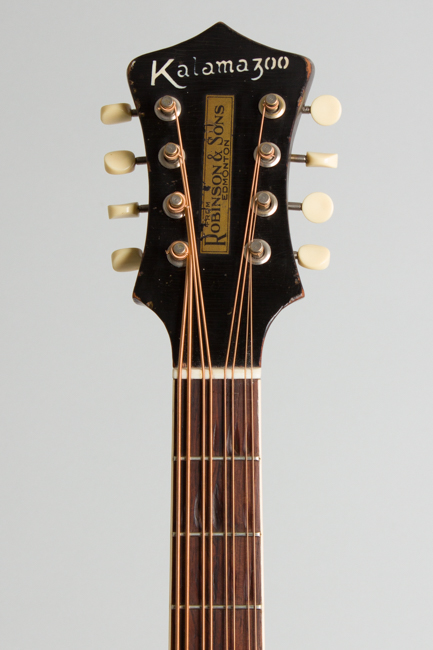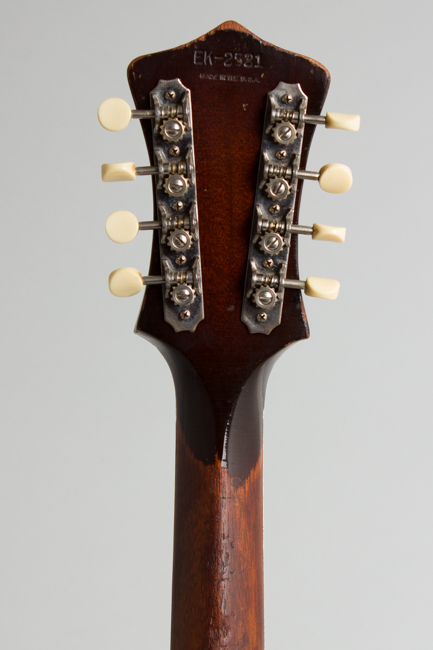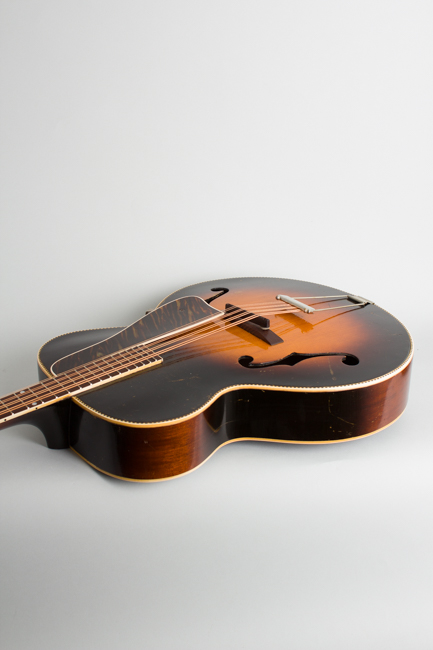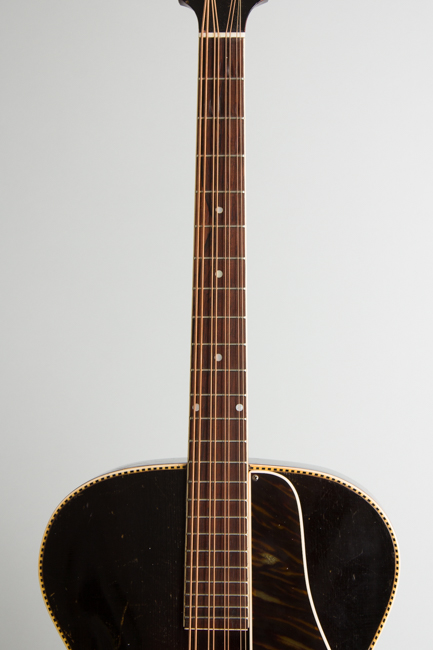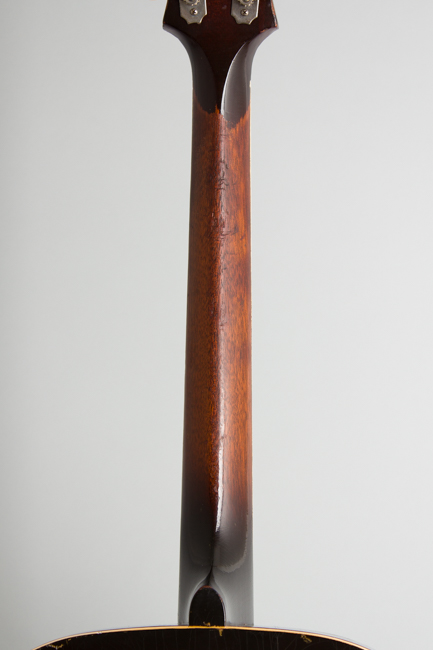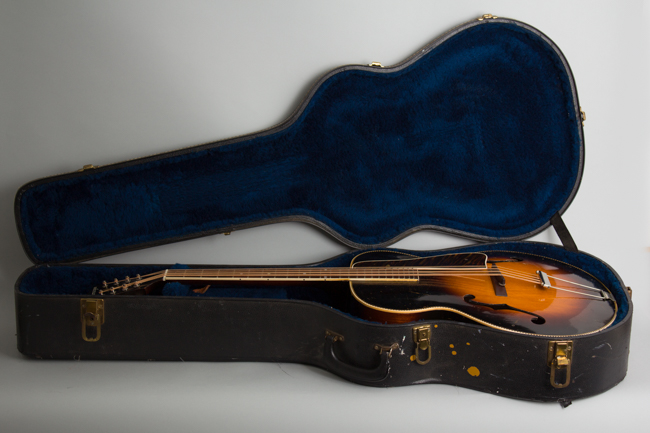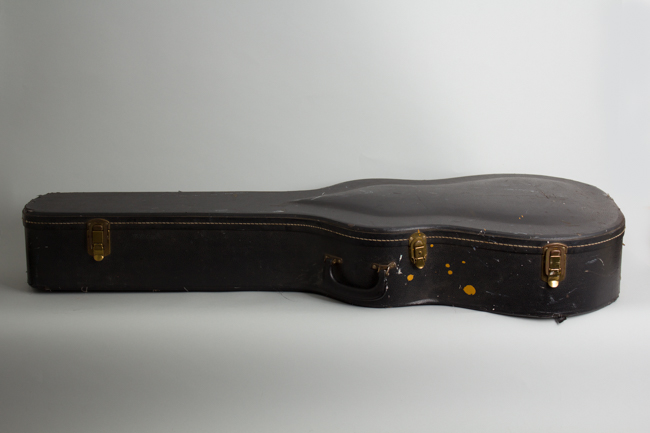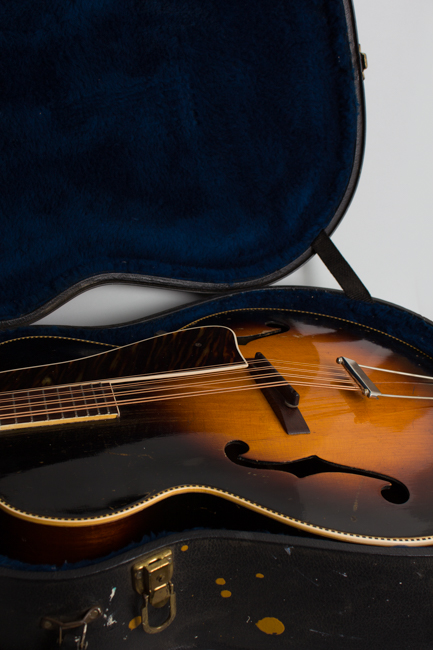Kalamazoo KK-31 Arch top Mandocello (1939)
This item has been sold.
Item # 10473
Prices subject to change without notice.
Kalamazoo KK-31 Model Arch top Mandocello (1939), made in Kalamazoo, Michigan, serial # EK-2521, sunburst lacquer finish, mahogany back, sides and neck, spruce top, rosewood fingerboard, black hard shell case.
This is a very interesting instrument, a Kalamazoo KK-31 mandocello from 1939. By the mid/late 1930s Gibson was making VERY few mandocellos, and the scattered examples that do appear in the traditional oval-body style look to have been primarily made up from leftover 1920s parts. The newer Kalamazoo branded KK-31 and KK-32 were introduced in 1936 as a simple budget-friendly 'cello solution. As they were built on production Kalamazoo archtop guitar bodies the model could be sold at a much lower price, listed retail in the US at $27.50.
Even these Kalamazoo mandocellos were only made in very small numbers. This one is stamped "Made in the U.S.A." on the back of the headstock, indicating it was marked at the factory for shipment outside the USA. Sure enough the decal from a Canadian dealer is still in place on the headstock face; we have found several of these that were sold beyond the borders of the US during the depression.
The spruce top has fairly large F-holes and is "arco-arched" in Gibson parlance, not carved but pressed into shape and braced to retain it. The fairly heavy X-brace pattern used has held its shape very well over 80+ years. The top and mahogany back are single bound, the top has a dramatic zipper pattern along the edge that really pops visually next to the medium/dark sunburst.
The mahogany neck is fairly slim with a "V" profile, as found on many Kalamazoos. The rosewood fingerboard is bound and dot inlaid. The neck is also in excellent shape, it is re-inforced with metal although there is no adjustable truss rod installed. The rosewood adjustable bridge, single bound firestripe pickguard, nickel plated trapeze tailpiece and early Kluson strip tuners are all original to the instrument.
While a budget line instrument when new, the KK-31 is an excellent player's piece and one of the very few pre-WWII F-hole mandocellos ever made, a fairly unique instrument in itself. Nearly all earlier Gibson mandocellos have smaller birch bodies, heavy carved spruce tops and oval soundholes. This 16" wide guitar-shaped mahogany instrument with a thin f-hole spruce top has a completely different and very lively sound, quite unlike most other specimens. The KK-31 is actually a very fine playing and sounding instrument that is more responsive than many mandocellos; it even fingerpicks very well. If you can't find an original Loar-era Gibson K-5, as far as vintage instruments go this is the next closest thing!
Overall length is 41 in. (104.1 cm.), 16 1/8 in. (41 cm.) wide at lower bout, and 3 1/4 in. (8.3 cm.) deep. Scale length is 24 3/4 in. (629 mm.). Width of nut is 1 1/2 in. (38 mm.).
This is a fairly well worn but quite playable instrument showing signs of use but no alterations The top shows a fairly random collection of pickwear strikes, dings, dents and scrapes. The back has heavier crazing, and some deeper scratches near the edges. The back of the neck has the most wear with much of the finish worn away and some deep capo dents along the spine. There is a small grain split off the top end of the bass side F hole, a long sealed crack on the bass side lower bout rim and another on the same side in the waist area, none causing any structural issues.
All hardware is original; the adjustment wheels on the original rosewood bridge have been replaced with stouter posts, making adjustment easier. The original pickguard is intact with one small spot of discoloration indicating celluloid decay will likely be its eventual fate. The headstock retains its original four-to-a-side white button Kluson tuners that still function smoothly.
The fretboard has recently received an expert refret with slightly larger fretwire than the original specification. The neck shows only minimal relief and plays very well, with a crisp and powerful sound unique to this instrument. While conceived as a low-budget gap filler, today the KK-31 seems a better and more interesting instrument than its creators likely realized. Very Good + Condition.
This is a very interesting instrument, a Kalamazoo KK-31 mandocello from 1939. By the mid/late 1930s Gibson was making VERY few mandocellos, and the scattered examples that do appear in the traditional oval-body style look to have been primarily made up from leftover 1920s parts. The newer Kalamazoo branded KK-31 and KK-32 were introduced in 1936 as a simple budget-friendly 'cello solution. As they were built on production Kalamazoo archtop guitar bodies the model could be sold at a much lower price, listed retail in the US at $27.50.
Even these Kalamazoo mandocellos were only made in very small numbers. This one is stamped "Made in the U.S.A." on the back of the headstock, indicating it was marked at the factory for shipment outside the USA. Sure enough the decal from a Canadian dealer is still in place on the headstock face; we have found several of these that were sold beyond the borders of the US during the depression.
The spruce top has fairly large F-holes and is "arco-arched" in Gibson parlance, not carved but pressed into shape and braced to retain it. The fairly heavy X-brace pattern used has held its shape very well over 80+ years. The top and mahogany back are single bound, the top has a dramatic zipper pattern along the edge that really pops visually next to the medium/dark sunburst.
The mahogany neck is fairly slim with a "V" profile, as found on many Kalamazoos. The rosewood fingerboard is bound and dot inlaid. The neck is also in excellent shape, it is re-inforced with metal although there is no adjustable truss rod installed. The rosewood adjustable bridge, single bound firestripe pickguard, nickel plated trapeze tailpiece and early Kluson strip tuners are all original to the instrument.
While a budget line instrument when new, the KK-31 is an excellent player's piece and one of the very few pre-WWII F-hole mandocellos ever made, a fairly unique instrument in itself. Nearly all earlier Gibson mandocellos have smaller birch bodies, heavy carved spruce tops and oval soundholes. This 16" wide guitar-shaped mahogany instrument with a thin f-hole spruce top has a completely different and very lively sound, quite unlike most other specimens. The KK-31 is actually a very fine playing and sounding instrument that is more responsive than many mandocellos; it even fingerpicks very well. If you can't find an original Loar-era Gibson K-5, as far as vintage instruments go this is the next closest thing!
Overall length is 41 in. (104.1 cm.), 16 1/8 in. (41 cm.) wide at lower bout, and 3 1/4 in. (8.3 cm.) deep. Scale length is 24 3/4 in. (629 mm.). Width of nut is 1 1/2 in. (38 mm.).
This is a fairly well worn but quite playable instrument showing signs of use but no alterations The top shows a fairly random collection of pickwear strikes, dings, dents and scrapes. The back has heavier crazing, and some deeper scratches near the edges. The back of the neck has the most wear with much of the finish worn away and some deep capo dents along the spine. There is a small grain split off the top end of the bass side F hole, a long sealed crack on the bass side lower bout rim and another on the same side in the waist area, none causing any structural issues.
All hardware is original; the adjustment wheels on the original rosewood bridge have been replaced with stouter posts, making adjustment easier. The original pickguard is intact with one small spot of discoloration indicating celluloid decay will likely be its eventual fate. The headstock retains its original four-to-a-side white button Kluson tuners that still function smoothly.
The fretboard has recently received an expert refret with slightly larger fretwire than the original specification. The neck shows only minimal relief and plays very well, with a crisp and powerful sound unique to this instrument. While conceived as a low-budget gap filler, today the KK-31 seems a better and more interesting instrument than its creators likely realized. Very Good + Condition.
